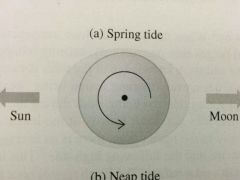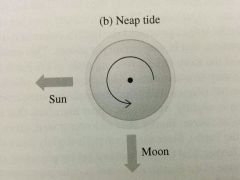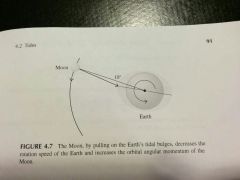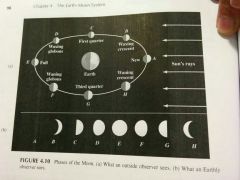![]()
![]()
![]()
Use LEFT and RIGHT arrow keys to navigate between flashcards;
Use UP and DOWN arrow keys to flip the card;
H to show hint;
A reads text to speech;
29 Cards in this Set
- Front
- Back
- 3rd side (hint)
|
Synchronous rotation |
The moon's sidereal rotation period equals its sidereal revolution period. The moon shows only the near side. |
|
|
|
Lunar liberations |
More than 50% of the Earth's surface is visible over a sidereal month - the surface "wobbles" and "nods" despite being locked into synchronous rotation. 59% is actually visible over the moon's orbital period. |
Wobble |
|
|
Diurnal liberation |
Due to diurnal parallax. An observer can see 1° father west in lunar longitude at moonset than at moonrise. |
|
|
|
Liberation in latitude |
East-West visibility due to moon's elliptical orbit. Because the moon's rotational speed is faster at perigee, a few more degrees of the right-hand face are visible just after perigee. The reverse is true just after apogee. About 6° |
|
|
|
Liberation in longitude |
Due to moon's 6.5° of axial tilt. More of the southernmost part of the moon's face is visible when the moon is North of the ecliptic, and vice versa. |
|
|
|
Oblate spheroid |
Sphere with a slight spare tire at the equator. Due to rapid rotation. |
|
|
|
Cause of precession |
Net torque on equatorial bulge due to tides attempts to align equatorial and ecliptic planes, instead causing the Earth's axial poles to change direction in a circle around the ecliptic pole |
|
|
|
Tide |
Distortion of equipotential surface. Most evident in Earth's oceans bulging towards the moon, but present even in solid bodies. |
|
|
|
Lunar vs solar tide |
Lunar tides are twice as strong as solar tides |
|
|
|
Spring tide |

Lunar and solar tides coincide to produce higher-amplitude tides |
|
|
|
Neap tide |

Lunar and solar tides sum destructively, causing lower amplitudes in tides. Sun and moon are at right angles. |
|
|
|
Cause of late tidal bulge |
A tidal bulge does not point directly at the moon because it encounters friction as it traverses the Earth. |
|
|
|
Tidal braking |

The moon pulls more strongly on the near tidal bulge causing bet torque which decreases Earth's angular momentum. .0016 sec/century |
|
|
|
How quickly is the moon receding? |
4 cm/year |
|
|
|
Roche limit |
The minimum radius at which a body can orbit another without being ripped apart by tidal forces |
|
|
|
Hill radius |
Maximum orbit size before satellite will escape planetary orbit |
|
|
|
Moon phases |

|
|
|
|
Waxing |
Visible portion turns towards observer, appears to grow. After new moon and before full. Lit on the right side. "White on the right grows night to night." |
|
|
|
Waning |
Visible portion of moon turns away from observer, appears to shrink. After full moon and before new. Lit on the left side. |
|
|
|
Moon's tilt relative to ecliptic plane |
5.1° |
|
|
|
Sidereal month |
Sidereal (measured against background stars) orbit of moon 27.322 days |
|
|
|
Synodic month |
Synodic (measured against Earth) period of moon; time elapsed between repeated phases |
|
|
|
Lunar eclipse |
Earth casts shadow on moon; Sun and Moon are at opposite nodes |
|
|
|
Solar eclipse |
Moon casts shadow on Earth; Sun and Moon are at same node |
|
|
|
Node |
Point at which the ecliptic plane intersects the Moon's path |
|
|
|
Line of nodes |
Line at which ecliptic plane intersects Moon's orbital plane |
|
|
|
Umbra |
Portion of shadow in which light source is completely blocked |
|
|
|
Penumbra |
Portion of shadow in which light source is partially blocked |
|
|
|
Annular eclipse |
Because the Moon is at apogee, the Sun is not completely blocked even in a total solar eclipse. A ring (annulus) of the Sun is visible around the Moon. |
|

